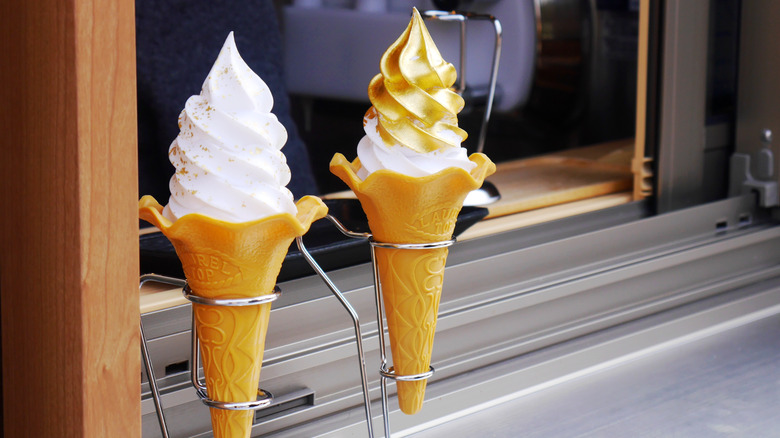The Willy Wonka-Style Ice Cream That Doesn't Melt (And How It's Made)
Seen as a beloved summertime staple and enjoyed around the world, ice cream is pure happiness in a cone. Though, you may prefer to spoon it out of a bowl instead, anticipating the inevitable sticky disaster that always follows when heat gets involved. If only there existed an ice cream that never melts, much like the creation spies stole from Willy Wonka in "Charlie and the Chocolate Factory." If ice cream soup isn't your thing, we have good news for you. A future with ice cream that doesn't melt might not be that far off for the U.S., because it was already accidentally discovered in Japan.
Flashback to 2011, when the Tōhoku earthquake, the strongest one the country had ever seen, demolished eastern Japan and triggered a tsunami that caused a full-blown nuclear reactor meltdown. It even wreaked havoc on local strawberry farms, causing them to become mishappen and bad for business. When the unsightly strawberries wouldn't sell, the Biotherapy Development Research Centre of Japan stepped in to brainstorm ways to make use of them. A pastry chef attempted to make cream using fresh strawberries but became frustrated because the cream turned out to be solid instead of fluffy. Kanazawa University investigated this oddity, and cue the eureka moment that led to the creation of ice cream that stays frozen.
What bizarre culinary sorcery goes into ice cream that doesn't melt, you ask? It's caused by an all-natural chemical compound found in strawberries and other plant-based foods called polyphenols.
Ice cream with polyphenols can withstand high temperatures
Move over Willy Wonka, because when it comes to never-melting ice cream, Japan is way ahead of you. After the discovery was made by Tomihisa Ota and his team of scientists, Kanazawa Ice began selling popsicles pressed into fun shapes with the strawberry extract in them. They knew their product would be successful based on the many tests performed on the polyphenol-infused treats. Some experiments involved blasting it with a hair dryer, holding it outside in 104-degree temperatures, and trying to set it on fire. All proved to be unsuccessful attempts at melting the ice cream.
In 2017, a CNET author put this new invention to the test. He reported that after 10 minutes in the hot sun, only the ears of his popsicle started to drip before he began eating it. Even just letting it sit in warm temperatures for three hours has resulted in only a slightly melted popsicle pal. Polyphenols are especially great news for slow eaters. This melt-free ice cream is currently sold in Japan in flavors like vanilla, chocolate, and mango.
Not only do polyphenols prevent water and oil from separating easily in foods, but they can also have health benefits when consumed. These could include improving brain function and digestion, fighting blood clots, and maintaining healthy blood sugar levels. Out of all the best kinds of ice cream out there, this one is definitely one to put on your radar.

